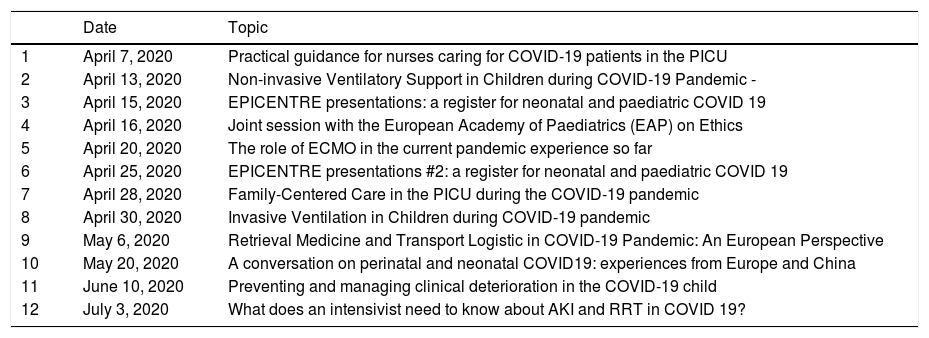
Edited by: Alberto García-Salido - Pediatric Intensive Care Unit, Hospital Infantil Universitario Niño Jesús, Madrid, Spain
Last update: May 2024
More infoThe coronavirus 2019 (COVID-19) pandemic represents a real challenge for the medical community. Considering these circumstances, the European Society of Paediatric and Neonatal Intensive Care (ESPNIC) analyzed how to efficiently reach its members, how to easily share updated content on the new disease, and how to implement new education and communication strategies.
A discussion on the impact of the pandemic on medical education has already been started within the medical community.1 The transition to online classes and the cancellation of clinical practice sessions, rotations and medical conferences, result in less collaborative experiences and networking, which are known to impact on the career development of young investigators.2 As a first step in the process of filling this gap, starting in 2020 spring, ESPNIC offered a series of webinars (promoted via social media as #ESPNICCOVID19 webinars) focusing on the management of COVID-19 in children and neonates (webinar topic list is uploaded as Electronic Supplementary Materials Table 1). Each webinar included 60min of free-to-access expert teaching followed by a 20-min discussion on the topic and the possibility of true networking with the speakers during and after the sessions. Almost 3000 people attended the ESPNIC webinars from 97 different countries (distribution displayed in ESM – Fig. 1). Interestingly, 15% were multidisciplinary healthcare providers not regularly working in the intensive care field. Besides the webinars, ESPNIC provided online tutorials focused on non-invasive and invasive ventilatory support, which was felt as most relevant topics for the audience in the given circumstances.
Topics of the ESPNIC webinar series held between April 1, 2020 and July 31, 2020.
| Date | Topic | |
|---|---|---|
| 1 | April 7, 2020 | Practical guidance for nurses caring for COVID-19 patients in the PICU |
| 2 | April 13, 2020 | Non-invasive Ventilatory Support in Children during COVID-19 Pandemic - |
| 3 | April 15, 2020 | EPICENTRE presentations: a register for neonatal and paediatric COVID 19 |
| 4 | April 16, 2020 | Joint session with the European Academy of Paediatrics (EAP) on Ethics |
| 5 | April 20, 2020 | The role of ECMO in the current pandemic experience so far |
| 6 | April 25, 2020 | EPICENTRE presentations #2: a register for neonatal and paediatric COVID 19 |
| 7 | April 28, 2020 | Family-Centered Care in the PICU during the COVID-19 pandemic |
| 8 | April 30, 2020 | Invasive Ventilation in Children during COVID-19 pandemic |
| 9 | May 6, 2020 | Retrieval Medicine and Transport Logistic in COVID-19 Pandemic: An European Perspective |
| 10 | May 20, 2020 | A conversation on perinatal and neonatal COVID19: experiences from Europe and China |
| 11 | June 10, 2020 | Preventing and managing clinical deterioration in the COVID-19 child |
| 12 | July 3, 2020 | What does an intensivist need to know about AKI and RRT in COVID 19? |
The “virtual wave” during the pandemic is confirmed by increased social media engagement in our field.3 In order to increase its educational impact, ESPNIC nominated a “Social Media board”, consisting of intensive care physicians, trainees, and communication experts. Scientific papers, literature contents, as well as qualified educational materials for young trainees, have been regularly shared, reaching over 3500 followers in the first few months. A recent analysis of the use of social media for sharing high-quality content during the pandemic identified ESPNIC as a point of reference in the networking pattern of the paediatric intensive care community.3
In conclusion, the COVID-19 pandemic represented a true accelerator of the teaching evolution into remote learning. These virtual formats have been proposed and applied by academic institutions and scientific societies as the “new normal” for postgraduate and continuing medical education. However, the complete shift of standard educational activities into their online version can lead to online networking tiredness, anxiety or worry secondary to the over-use of these virtual tools, known as “Zoomfatigue”.4 This phenomenon should not be underestimated, and a real balance should be reached between communication and information overload. The evolution of information spreading through social media is also worth noting. Despite the hardship, ESPNIC remains committed to maintaining the same high-level support for its members and for the #PedsICU and #NICU community. ESPNIC's experience could represent a useful example for other scientific societies and organizations which are implementing new, creative education and communication strategies.
Authors’ contributionsAll authors equally contributed to the study's conceptualization. ZG, FS and AZ wrote the first draft of this manuscript which was then critically reviewed and amended by AM and MK. AZ gathered and analyzed the dataset about webinar participants. ZG prepared the figure and tables for the electronic supplementary material. All authors read and approved the final manuscript.
FundingNo financial support was used or received for this work.
Conflict of interestAt the time of writing this manuscript, AM, MK and AZ were members of the executive committee of the European Society for Paediatric and Neonatal Intensive Care (ESPNIC). ZG and FS were members of the ESPNIC Social Media board. The authors have no conflicts of interest to declare.
The authors thank Pamela Funes, Liliya Buyukliyska and Gianinna Di Conza Villa for their technical support.








